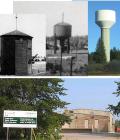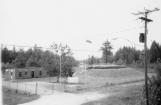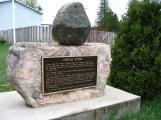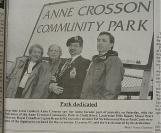1
MUNICIPAL STRUCTURE:PRIOR TO OCTOBER 11 1859 THERE WERE SIX TOWNSHIPS UNITED
TOGETHER NAMELY; ALICE, BUCHANAN, McKAY, PETAWAWA, ROLPH
AND WYLIE.
ON OCT. 11 1859, ALICE TOWNSHIP SEVERED FROM THE REMAINING
FIVE TOWNSHIP'S. IT WAS ALSO ENACTED AT THAT TIME THAT ROLPH
TOWNSHIP BE KNOWN AS THE SENIOR TOWNSHIP.
ON JAN. 1 1865, PETAWAWA TOWNSHIP SEVERED . LEAVING THE NOW
EXISTING FOUR TOWNSHIPS.
IN 1855, ROLPH TWP. WAS FOUNDED, NAMED AFTER THE HONORABLE
JOHN ROLPH. M.D. WHO FOUNDED THE TORONTO SCHOOL OF MEDICINE.
IN 1855, McKAY TWP. WAS FOUNDED, NAMED AFTER THE HONORABLE
THOMAS McKAY, M.P. FOR RUSSELL COUNTY IN 1835. THE HON.
THOMAS McKAY BUILT RIDEAU HALL AS A PRIVATE HOME.
IN 1857, BUCHANAN TWP. WAS FOUNDED, THERE IS SOME DISPUTE
AS TO WHOM THE TWP.IS ACTUALLY NAMED AFTER. WHETHER IT BE
THE HONORABLE ISAAC BUCHANAN OR MR. GEORGE BUCHANAN. FROM
ARNPRIOR.
IN 1864, WYLIE TWP. WAS FOUNDED. NAMED AFTER THE HONORABLE
JAMES WYLIE. A MEMBER OF THE LEGISLATURE COUNCIL PRIOR TO
CONFEDERATION.
ON JAN. 1 1954, CHALK RIVER WAS INCORPORATED AS A VILLAGE.
ON 1 JAN. 2000 THE FORMER VILLAGE OF CHALK RIVER
AND THE FORMER TWPS. OF ROLPH, BUCHANAN , WYLIE
AND McKAY WERE AMALGAMATED TO FORM THE TOWN
OF LAURENTIAN HILLS
2
Municipal ServicesIn 1954 Chalk River became incorporated as a Village, and formed it's own village council with it's first Reeve being Mr Con Dover who had been a member of the Municipal Council for the Townships. Other members of the Council were Mr Joe Hawley, Mr. Walter Coxford, Mr. R.W. Law and Mr Ed Touzel. Our Village's first clerk was Mr Orland Leach, while the first Treasurer was Mrs Mabel Coxford
Hydro electric power first came to Chalk River in 1945-46 , however most residents did not receive it into their homes until 1947-48. Chalk River, being part of the combined Townships of Rolph, Buchanan, Wylie & Mckay at that time , operated under the rural system and not under a commission as it does today (1979). (Chalk River was incorporated as a Village on 1 Jan.1954).
In 1956 Village Council received permission from Ontario Hydro to buy electricity in bulk and retail it to village customers with local residents governing the business. By 1958 a commission made up of Reeve C.C.Dover, Chairman Robert Seguin and Maurice Blimkie was elected as the first Hydro Commission of Chalk River. Reeve Robert Seguin, today (1979) 23 years later is still serving as Chairman of the Commission.
Mr Gordon Tennant was the first meter reader hired by the new Commission. Later when water was installed to all homes in the village in 1965, the Commission also looked after this system, and so became known as the Chalk River Public Utilities Commission. Today (1979) the Sewage system is also a part of the P.U.C.
Prior to this, gas or coal -oil lamps were used for lighting except for the C.P.R. who had their own Delco System operating from their shops and supplying all their needs. It also supplied the Chalk River open air rink with lights until 1948.
Four years after the incorporation of Chalk River we progressed from cinder to paved streets.
Just ten years after incorporation, in 1965, the CPR water system was purchased and piped into village homes.
Public sewers were installed in 1975 with a disposal plant being built at a point where Blimkie Street crosses the Black Duck Lake creek , ( later known as Reckzine Creek),on land donated to the town by the Chalk River Branch of the Royal Canadian Legion.
Despite the decline in employment opportunities with the Railway Chalk River continued to grow, first as a bedroom community for the Chalk River Laboratories of Atomic Energy of Canada ( 5 miles / 8 km to the North) and later for the Canadian Forces Base Petawawa, 10 miles (16 km) to the East. Municipal records reveal the addition of Wilson Street in 1972, Cook Street in 1972, Dover Lane in 1972, Laroche Street in 1976, and Bob Seguin Dr in 1994.
4
Evolution of Chalk River Water systemWhile the original Pumphouse was situated on the creek leading from Black Duck Lake, about 1960 this supply proved to be inadequate and the CPR built a new pumping station and supply line at Corry Lake.
Just ten years after incorporation, in 1965, the CPR water system was purchased and piped into village homes.
Upgrades and expansion of the system have taken place through the ensuing years to keep pace with physical and legislative requirments. The present Water Treatment plant was built in the early 1990's.
6
Public sewers were installed in 1975 with a disposal plant being built at a point where Blimkie Street crosses the Black Duck Lake creek , (later known as Reckzine Creek),on land donated to the town by the Chalk River Branch of the Royal Canadian Legion.8
FIRE DEPARTMENT:With water readily available , after the purchase of the C.P.R. water system in 1956, it was possible under the direction of Mr Tom Tennant as Fire Chief, to form a volunteer fire Department. The former Reynolds Garage as well as a new fire truck were purchased. Mr Tennant has moved , and is presently (1979) Fire Chief over three or four Municipalities outside of Ottawa. Today (1979) the department consists of 22 firemen under the direction of Fire Chief Jim Watters.
Through the ensuing years ( 1979 - 2000) the Chalk River Fire Department , under the direction of Fire Chiefs Levassuer, Watters, Daynard, and Hopkins continued to provide Fire Protection service to the citizens of Chalk River. Equipment upgrades and training progressed as the profession evolved with a constant target of meeting both IFSTA and Provincial standards, and local needs.
In the beginning, firefighters were alerted through a party line fire-phone system in each of their homes. This progressed to a local pager system with on call firefighters carrying the pagers and finally to a part of the County wide 911 system.
In January 2000, the Village of Chalk River amalgamated with the Combined Townships of Rolph, Buchanan, Wylie and McKay to form the new municipality of Laurentian Hills. With this amalgamation the Chalk River Fire Department became a part of the Fire Department of Laurentian Hills under the direction of Chief Waito, with expanded responsibilities which included initial response of trucks from Chalk River to fires on all lands from the southern boundary of Laurentian Hills to Millers Road and on the Wylie Road as far as the Bronson Road. They also cooperate with the Deep River Department on Auto Extrication work .
Currently the full Department consists of 39 persons who are on call for fires throughout the Town of Laurentian Hills. 18 if these respond from the Chalk River Fire Hall.
In addition to fire suppression, the Department conducts "on request or complaint" fire prevention inspections.
In 2003 a new Fire Hall was built in Chalk River to house both Fire and Ambulance services.
10
BY VANCE GUTZMANHenry Hudson may have become lost, but the stone which is fabled to bear his initials has finally found itself a home. Chalk River residents Tom Tennant and Ray Brisebois, along with help of other volunteers, have mounted the Hudson Stone in a small park at the intersection of Church and Wilson Streets. The mounting of the stone is the culmination of a long road travelled by the stone, beginning 38 years ago when it was discovered by a road crew repaying Highway 17 at the eastern end of Deep River.
The large rock, weighing about 150 pounds, has words etched into it which read HH 1612 CAPTIVE. Some people believe the message was inscribed by famed explorer Henry Hudson. It is believed he was set adrift in James Bay in 1611, following a mutiny while on his fourth attempt to discover the Northwest Passage.
There is speculation that the explorer may have made his way south following the mutiny, and was then captured by Indians. Glenn Cuthbert was a member of the road crew that made the initial discovery of the rock. He had it moved to his home in Prescott, where it piqued the interest of Tennant, who is Cuthbert's brother-in-law. Tennant was able to persuade Cuthbert that the stone should be returned to this area. Cuthbert agreed, and for the last few years, Tennant, along with Brisebois, has been trying to find a proper setting for the stone in the village. Village council told Tennant earlier this year that it had no money to spare for the project. Unfazed, Tennant and Brisebois went ahead with their plans anyway. The first thing they did, was pour a cement slab. Into this they sank the base of a large slab of fieldstone, which weighs about 450 pounds. On top of the fieldstone, they mounted the Hudson Stone. One of the hardest parts of the whole experience was when the two men had to manhandle the Hudson Stone from Brisebois' backyard to its present location. Now that the historic rock is in a place where everybody can admire it, Tennant is lobbying the Ontario Heritage Foundation for help in erecting a plaque at the monument. He hopes to have that. phase of the project completed by next spring. "It's a relief to finally have it in a location where people can see it," Tennant said. "Now we can see it and work around it to improve the community park."




